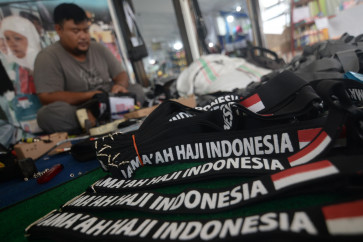BRI investment must avoid debt trap: Analysts
The government needs to be careful in offering projects to China’s investors as part of the trillion-dollar Belt and Road Initiative (BRI) financing program as there are risks of falling into a debt trap, economists have warned
Change text size
Gift Premium Articles
to Anyone

T
he government needs to be careful in offering projects to China’s investors as part of the trillion-dollar Belt and Road Initiative (BRI) financing program as there are risks of falling into a debt trap, economists have warned.
They also called for transparency in everything related to the financing for BRI-related projects.
Institute for Development of Economics and Finance (INDEF) economist Zulfikar Rachmat said the risk of a debt trap was real as China is believed to have long-term goals of spreading political influence, not simply looking to make a profit.
“China has two objectives in the BRI program, economic and then political. China wants to spread influence in those countries. That’s why our government should be fully aware of this,” he told The Jakarta Post on Friday.
The BRI is a program by China to strengthen infrastructure, trade and investment cooperation with at least 65 countries. The program is set to account for 30 percent of global gross domestic product (GDP) and will require up to US$6 trillion of investment by 2030.
According to a United States-based nonprofit think tank Center for Global Development, however, at least eight countries are already at serious risk of not being able to repay their loans to China.
The eight countries, Djibouti, Kyrgyzstan, Laos, the Maldives, Mongolia, Montenegro, Pakistan and Tajikistan, are believed to owe more than half of all their foreign debt to China.
Zulfikar said the risk could be minimized if the government could maintain strong bargaining power in its investment negotiations with China, such as utilizing Indonesia’s position as one of the crucial parts of what China has described as the “New Silk Road”.
“The government should utilize fully the position of Indonesia as a crucial part of China’s Silk Road development, making China the one that needs Indonesia not the other way around,” he said.
The government has announced four investment requirements for China in the BRI, namely installing only high-class technology that is also environmentally friendly; transfers of technology; use of local manpower; and any project should add real value.
Regarding Indonesia’s financial capability, Center of Reform on Economics (CORE) lead researcher Mohammad Faisal said the country was still able to meet debt payments.
“We’re relatively sound compared with other countries, if we examine the debt-to-GDP ratio of 30 percent. Especially as the loans are for infrastructure projects,” he said in a text message on Friday.
Nevertheless Faisal warned the government to pay close attention to the loan management and to ensure project accountability, especially in the multiplier effects of each project.
“Transparency is a must, not just focusing on physical development. Public involvement in planning, implementation and monitoring is an important stage in infrastructure development, to maximize utilization and reduce community resistance,” he said.
Vice President Jusuf Kalla and Coordinating Maritime Affairs Minister Luhut Pandjaitan, are currently attending the second BRI Forum in Beijing.
In the summit, Chinese President Xi Jinping pledged that the implementation of the US$1 trillion program would promote good governance and sustainable development.
Indonesia is reportedly planning to offer 28 projects worth $91.1 billion at the BRI forum, at least four of which are coal-fired power plants that in total will have a capacity at 2 gigawatts (GW).
Faisal said transparency should be ensured in all aspects, such as feasibility studies, the profits that could be taken, the cost per year and the duration for break-even point.
“Of those 28 projects, the government should only prioritize those that have a better chance of repayment. Never finance a project that lacks urgency or that will have a low impact on society,” he said.
Beside worries about the debt trap issue, there are also concerns about a supply-and-demand mismatch in the government’s proposed projects for the energy sector.
One of the four projects regarded by environmental watchdog Greenpeace as pointless is the Celukan Bawang 2 power plant in Bali, with a planned capacity of 2x330 megawatts (MW).
Adila Isfandiari, a climate and energy researcher for Greenpeace, said Bali’s electricity supply exceeded demand.
“Our existing power capacity [in Bali] as of December 2018 was 1,287 MW, while our peak demand was only 872 MW, so we have [around] 40 percent of unused supply,” she said recently.









